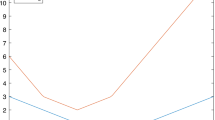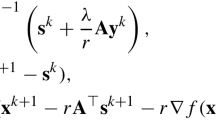Abstract
Since Karmarkar published his algorithm for linear programming, several different interior directions have been proposed and much effort was spent on the problem transformations needed to apply these new techniques. This paper examines several search directions in a common framework that does not need any problem transformation. These directions prove to be combinations of two problem-dependent vectors, and can all be improved by a bidirectional search procedure.
We conclude that there are essentially two polynomial algorithms: Karmarkar's method and the algorithm that follows a central trajectory, and they differ only in a choice of parameters (respectively lower bound and penalty multiplier).
Similar content being viewed by others
References
I. Adler, M. Resende, and G. Veiga. An Implementation of Karmarkar's Algorithm for Linear Programming. Report ORC86-8, Operations Research Center, University of California, Berkeley, May 1986.
K. Anstreicher. A monotonic projective algorithm for fractional linear programming.Algorithmica,1:483–498, 1986.
E. R. Barnes. A variation on Karmarkar's algorithm for solving linear programming problems.Mathematical Programming,36:174–182, 1986.
E. R. Barnes and D. L. Jensen. A Polynomial-Time Version of the Affine-Scaling Algorithm. Manuscript in preparation, IBM Thomas J. Watson Research Center, Yorktown Heights, NY, 1987.
K. Bayer and J. C. Lagarias. Karmarkar's Linear Programming Algorithm and Newton's Method. Preprints, AT&T Bell Laboratories, Murray Hill, NJ, 1986.
T. Cavalier and A. Soyster. Some Computational Experience and a Modification of the Karmarkar Algorithm. Working Paper 85–105, Department of Industrial and Management System Engineering, Pennsylvania State University, February 1985.
W. C. Davidon. Conic approximations and collinear scalings for optimizers.SIAM Journal on Numerical Analysis,17:268–281, 1980.
A. Fiacco and G. McCormick. Nonlinear Programming: Sequential Unconstrained Minimization Techniques. Wiley, New York, 1955.
K. R. Frisch. The Logarithmic Potential Method of Convex Programming. Memorandum, University Institute of Economics, Oslo, May 1955.
D. Gay. A variant of Karmarkar's linear programming algorithm for problems in standard form.Mathematical Programming,37:81–89, 1987.
P. Gill, W. Murray, M. Saunders, J. Tomlin, and M. Wright. On projected Newton barrier methods for linear programming and an equivalence to Karmarkar's projective method.Mathematical Programming,36:183–209, 1986.
C. Gonzaga. A Conical Projection Algorithm for Linear Programming. Memorandum UCB/ERL M85/61, Electronics Research Laboratory, University of California, Berkeley, CA, July 1985.
C. Gonzaga. An Algorithm for Solving Linear Programming Problems inO(n 3 L) operations. Memorandum UCB/ERL M87/10, Electronics Research Laboratory, University of California, Berkeley, CA, March 1987.
C. Gonzaga. Conical Projection Algorithms for Linear Programming. Memorandum UCB/ERL M87/11, Electronics Research Laboratory, University of California, Berkeley, CA, March 1987. To appear inMathematical Programming.
H. Imai. On the convexity of the multiplicative version of Karmarkar's potential function.Mathematical Programming,40:29–32, 1988.
M. Iri and H. Imai. A multiplicative penalty function method for linear programming.Algorithmica,1:455–482, 1986.
N. Karmarkar. A new polynomial time algorithm for linear programming.Combinatorica,4:373–395, 1984.
J. C. Lagarias. Personal communication.
N. Megiddo. Pathways to the Optimal Set in Linear Programming. Research Report RJ 5295, IBM Almaden Research Center, San Jose, CA, 1986.
M. Padberg. Solution of a Nonlinear Programming Problem Arising in the Projective Method for Linear Programming. Manuscript, New York University, New York, March 1985.
J. Renegar. A polynomial-time algorithm based on Newton's method for linear programming.Mathematical Programming,40:59–94, 1988.
M. Todd and B. Burrell. An extension of Karmarkar's algorithm for linear programming using dual variables.Algorithmica,1:409–424, 1986.
P. M. Vaidya. An Algorithm for Linear Programming which RequiresO(((m+n)n 2+(m+n)1.5 n)L) Arithmetic Operations. Preprint, AT&T Bell Laboratories, Murray Hill, NJ, 1987.
R. J. Vanderbei, M. J. Meketon, and B. A. Freedman. A modification of Karmarkar's linear programming algorithm.Algorithmica,1:395–407, 1986.
H. Yamashita. A Polynomially and Quadratically Convergent Method for Linear Programming. Manuscript, Mathematical Systems Institute Inc., Tokyo, October 1986.
Author information
Authors and Affiliations
Additional information
Communicated by Nimrod Megiddo.
Research partly sponsored by CNPq-Brazilian National Council for Scientific and Technological Development, by National Science Foundation Grant ECS-8121149, Office of Naval Research Contract N00014-83-K-0602, AFOSR Grant 83-0361, State of California Microelectronics Innovation and Computer Research Opportunities Program, and General Electric.
On leave from COPPE-Federal University of Rio de Janeiro, Cx. Postal 68511, 21941 Rio de Janeiro, RJ, Brasil.
Rights and permissions
About this article
Cite this article
Gonzaga, C.C. Search directions for interior linear-programming methods. Algorithmica 6, 153–181 (1991). https://doi.org/10.1007/BF01759039
Received:
Revised:
Issue Date:
DOI: https://doi.org/10.1007/BF01759039




